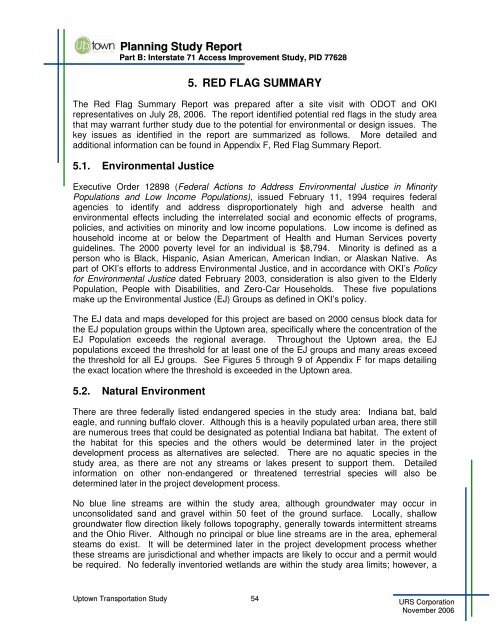Uptown Transportation Study - OKI
Uptown Transportation Study - OKI
Uptown Transportation Study - OKI
Create successful ePaper yourself
Turn your PDF publications into a flip-book with our unique Google optimized e-Paper software.
Planning <strong>Study</strong> ReportPart B: Interstate 71 Access Improvement <strong>Study</strong>, PID 776285. RED FLAG SUMMARYThe Red Flag Summary Report was prepared after a site visit with ODOT and <strong>OKI</strong>representatives on July 28, 2006. The report identified potential red flags in the study areathat may warrant further study due to the potential for environmental or design issues. Thekey issues as identified in the report are summarized as follows. More detailed andadditional information can be found in Appendix F, Red Flag Summary Report.5.1. Environmental JusticeExecutive Order 12898 (Federal Actions to Address Environmental Justice in MinorityPopulations and Low Income Populations), issued February 11, 1994 requires federalagencies to identify and address disproportionately high and adverse health andenvironmental effects including the interrelated social and economic effects of programs,policies, and activities on minority and low income populations. Low income is defined ashousehold income at or below the Department of Health and Human Services povertyguidelines. The 2000 poverty level for an individual is $8,794. Minority is defined as aperson who is Black, Hispanic, Asian American, American Indian, or Alaskan Native. Aspart of <strong>OKI</strong>’s efforts to address Environmental Justice, and in accordance with <strong>OKI</strong>’s Policyfor Environmental Justice dated February 2003, consideration is also given to the ElderlyPopulation, People with Disabilities, and Zero-Car Households. These five populationsmake up the Environmental Justice (EJ) Groups as defined in <strong>OKI</strong>’s policy.The EJ data and maps developed for this project are based on 2000 census block data forthe EJ population groups within the <strong>Uptown</strong> area, specifically where the concentration of theEJ Population exceeds the regional average. Throughout the <strong>Uptown</strong> area, the EJpopulations exceed the threshold for at least one of the EJ groups and many areas exceedthe threshold for all EJ groups. See Figures 5 through 9 of Appendix F for maps detailingthe exact location where the threshold is exceeded in the <strong>Uptown</strong> area.5.2. Natural EnvironmentThere are three federally listed endangered species in the study area: Indiana bat, baldeagle, and running buffalo clover. Although this is a heavily populated urban area, there stillare numerous trees that could be designated as potential Indiana bat habitat. The extent ofthe habitat for this species and the others would be determined later in the projectdevelopment process as alternatives are selected. There are no aquatic species in thestudy area, as there are not any streams or lakes present to support them. Detailedinformation on other non-endangered or threatened terrestrial species will also bedetermined later in the project development process.No blue line streams are within the study area, although groundwater may occur inunconsolidated sand and gravel within 50 feet of the ground surface. Locally, shallowgroundwater flow direction likely follows topography, generally towards intermittent streamsand the Ohio River. Although no principal or blue line streams are in the area, ephemeralsteams do exist. It will be determined later in the project development process whetherthese streams are jurisdictional and whether impacts are likely to occur and a permit wouldbe required. No federally inventoried wetlands are within the study area limits; however, a<strong>Uptown</strong> <strong>Transportation</strong> <strong>Study</strong> 54URS CorporationNovember 2006
















